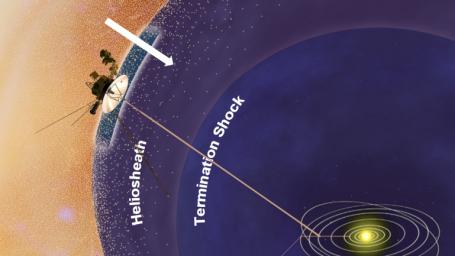
|
Energetic Particles from Outside our Solar System Increase (Artist’s Concept)
- Click the image above for a larger view
- Full-Res JPEG (1280 x 720) (103.7 kB)
- Full-Res TIFF (1280 x 720) (2.8 MB)
Caption:
This artist's concept shows NASA's Voyager 1 spacecraft in a new region at the edge of our solar system where the amount of high-energy particles diffusing into our solar system from outside has increased. Voyager 1 is in an area scientists are calling the stagnation region, at the outer layer of the heliosphere, or magnetic bubble that the sun blows around itself. These energetic particles, which are cosmic rays in interstellar space, have increased 100 times between the time Voyager 1 passed the termination shock in 2004 and mid-2010, when the spacecraft entered the new region. The termination shock is where the solar wind dramatically slows down and becomes turbulent. The spacecraft has detected a steadily increasing abundance of the cosmic ray particles since Voyager 1 first crossed the termination shock. The increase indicates that Voyager 1 is approaching interstellar space.
Background Info:
The Voyager spacecraft were built by NASA's Jet Propulsion Laboratory in Pasadena, Calif., which continues to operate both. JPL is a division of the California Institute of Technology. The Voyager missions are a part of the NASA Heliophysics System Observatory, sponsored by the Heliophysics Division of the Science Mission Directorate in Washington. For more information about the Voyager spacecraft, visit http://www.nasa.gov/voyager .
Cataloging Keywords:
| Name | Value | Additional Values |
|---|---|---|
| Target | Heliosphere | |
| System | Solar System | |
| Target Type | Heliosphere | |
| Mission | Voyager | |
| Instrument Host | Voyager 1 | |
| Host Type | Flyby Spacecraft | |
| Instrument | ||
| Detector | ||
| Extra Keywords | Artwork, Color, Magnetosphere | |
| Acquisition Date | ||
| Release Date | 2011-12-16 | |
| Date in Caption | ||
| Image Credit | NASA/JPL-Caltech | |
| Source | photojournal.jpl.nasa.gov/catalog/PIA15177 | |
| Identifier | PIA15177 | |
